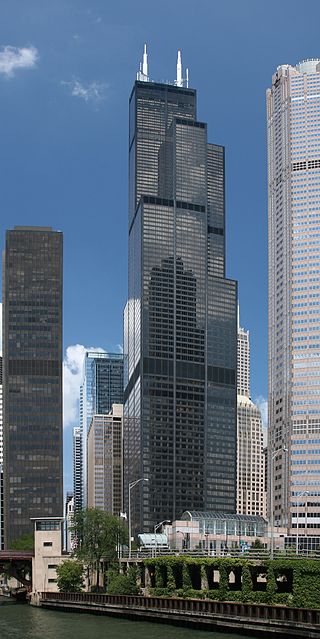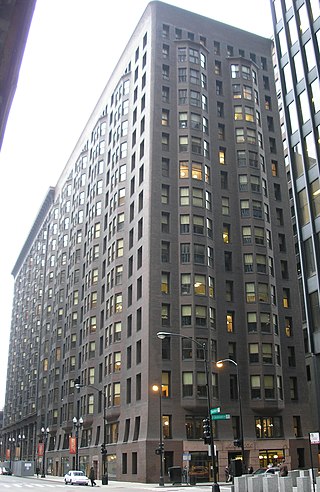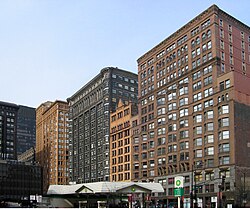Description
The Printing House Row District includes four buildings that present facades onto South Dearborn Street, between West Jackson Boulevard and West Ida B. Wells Drive. At the northern end stands the Monadnock Building, occupying the entire block of South Dearborn and South Federal between Jackson and Van Buren. Opposite the southern portion of the Monadnock stands the Fisher Building, fronting on South Dearborn and Van Buren. Across Van Buren on the east side of South Dearborn is the Old Colony Building, with the Manhattan Building to its south. [4]
Each of these buildings is significant for its architecture and/or for advances in skyscraper construction methods in the 1880s and 1890s. The Manhattan Building, built in 1889–91 to a design by William Le Baron Jenney, was the first skyscraper supported entirely by an internal metal skeleton, and was the tallest building in the world at its completion. The Old Colony Building, built in 1893–94 to a design by Holabird & Roche, demonstrated a means to build skyscrapers on narrow lots, yet provided sufficient strength to its floors to withstand the operational stresses of printing equipment. The Fisher Building, built in 1895–96 to a design by Daniel H. Burnham, is one of the first buildings to use curtain wall construction. Lastly, the Monadnock, built in two stages, one designed by Burnham & Root and the other by Holabird & Roche, is one of the largest commercial buildings with load-bearing masonry walls ever built. [4]

The Loop, one of Chicago's 77 designated community areas, is the central business district of the city and is the main section of Downtown Chicago. Home to Chicago's commercial core, it is the second largest commercial business district in North America and contains the headquarters and regional offices of several global and national businesses, retail establishments, restaurants, hotels, and theaters, as well as many of Chicago's most famous attractions. It is home to Chicago's City Hall, the seat of Cook County, and numerous offices of other levels of government and consulates of foreign nations. The intersection of State Street and Madison Street, located in the area, is the origin of the address system of Chicago's street grid. Most of Grant Park's 319 acres (1.29 km2) are in the eastern section of the community area. The Loop community area is bounded on the north and west by the Chicago River, on the east by Lake Michigan, and on the south by Roosevelt Road.

The buildings and architecture of Chicago reflect the city's history and multicultural heritage, featuring prominent buildings in a variety of styles. Most structures downtown were destroyed by the Great Chicago Fire in 1871.

William Le Baron Jenney was an American architect and engineer known for building the first skyscraper in 1884.

The Near South Side is a community area of Chicago, Illinois, United States, just south of the downtown central business district, the Loop. The Near South Side's boundaries are as follows: North—Roosevelt Road ; South—26th Street; West—Chicago River between Roosevelt and 18th Street, Clark Street between 18th Street and Cermak Road, Federal between Cermak Road and the Stevenson Expressway just south of 25th Street, and Clark Street again between the Stevenson and 26th Street; and East—Lake Michigan.

The Monadnock Building is a 16-story skyscraper located at 53 West Jackson Boulevard in the south Loop area of Chicago. The north half of the building was designed by the firm of Burnham & Root and built starting in 1891. At 215 feet, it is the tallest load-bearing brick building ever constructed. It employed the first portal system of wind bracing in the United States. Its decorative staircases represent the first structural use of aluminum in building construction. The later south half, constructed in 1893, was designed by Holabird & Roche and is similar in color and profile to the original, but the design is more traditionally ornate. When completed, it was the largest office building in the world. The success of the building was the catalyst for an important new business center at the southern end of the Loop.

The Gage Group Buildings consist of three buildings located at 18, 24 and 30 S. Michigan Avenue, between Madison Street and Monroe Street, in Chicago, Illinois. They were built from 1890–1899, designed by Holabird & Roche for the three millinery firms - Gage, Keith and Ascher. The building at 18 S. Michigan Avenue has an ornamental façade designed by Louis Sullivan. It was listed on the National Register of Historic Places on November 14, 1985, and was designated a Chicago Landmark on September 11, 1996. In addition, it is a historic district contributing property for the Chicago Landmark Historic Michigan Boulevard District.

The Manhattan Building is a 16-story building at 431 South Dearborn Street in Chicago, Illinois. It was designed by architect William Le Baron Jenney and constructed from 1889 to 1891. It is the oldest surviving skyscraper in the world to use a purely skeletal supporting structure. The building was the first home of the Paymaster Corporation, and is listed on the National Register of Historic Places on March 16, 1976, and designated a Chicago Landmark on July 7, 1978.

The Marquette Building, completed in 1895, is a Chicago landmark that was built by the George A. Fuller Company and designed by architects Holabird & Roche. The building is currently owned by the John D. and Catherine T. MacArthur Foundation. It is located in the community area known as the "Loop" in Cook County, Illinois, United States.

The Chicago Board of Trade Building is a 44-story, 604-foot (184 m) Art Deco skyscraper located in the Chicago Loop, standing at the foot of the LaSalle Street canyon. Built in 1930 for the Chicago Board of Trade (CBOT), it has served as the primary trading venue of the CBOT and later the CME Group, formed in 2007 by the merger of the CBOT and the Chicago Mercantile Exchange. In 2012, the CME Group sold the CBOT Building to a consortium of real estate investors, including GlenStar Properties LLC and USAA Real Estate Company.

The Fisher Building is 20-story, 275-foot-tall (84 m) neo-Gothic landmark building located at 343 South Dearborn Street in the Chicago Loop community area of Chicago. Commissioned by paper magnate Lucius Fisher, the original building was completed in 1896 by D.H. Burnham & Company with an addition later added in 1907.

The Arc at Old Colony is a 17-story landmark building in the Chicago Loop community area of Chicago, Illinois. Designed by the architectural firm Holabird & Roche in 1893–94, it stands at approximately 215 feet and was the tallest building in Chicago at the time it was built. The building was designated a Chicago Landmark on July 7, 1978. It was the first tall building to use a system of internal portal arches as a means of bracing the structure against high winds.

The Prairie Avenue District is a historic district in the Near South Side community area of Chicago, Illinois. It includes the 1800 and 1900 blocks of South Prairie Avenue and the 1800 block of South Indiana, and 211-217 East Cullerton. It was the site of the Battle of Fort Dearborn and became the city's most fashionable residential district after the Great Chicago Fire. It was designated a Chicago Landmark on December 27, 1979. The district was added to the National Register of Historic Places on November 15, 1972. The John J. Glessner House, designed and built by Henry Hobson Richardson in 1885–1886 at 1800 S. Prairie Avenue, has been restored as a historic house museum, and is open for public tours. In 2006, the Prairie District Neighborhood Alliance, a non-profit organization was formed to provide representation for thousands of South Loop residents, including the Prairie Avenue District, Central Station, Museum Park, Motor Row, and the South Michigan Avenue Corridor, as well as other areas of the Near South Side.

333 North Michigan is a skyscraper in the art deco style located in the Loop community area of Chicago, Illinois in the United States. Architecturally, it is noted for its dramatic upper-level setbacks that were inspired by the 1923 skyscraper zoning laws. Geographically, it is known as one of the four 1920s flanks of the Michigan Avenue Bridge that are contributing properties to the Michigan–Wacker Historic District, which is a U.S. Registered Historic District.

George A. Fuller was an American architect often credited as being the "inventor" of modern skyscrapers and the modern contracting system.
South Loop Printing House District is a historic district in the downtown Chicago Loop area of Chicago, Illinois. The district is roughly bounded by Congress, Polk, State, Taylor, and Wells Streets and includes 28 contributing buildings. The district includes many of the printing buildings used by Chicago's printing industry, the largest in the midwest from the 1880s through the 1930s. Due to its proximity to Dearborn Station and its thin property blocks that allowed for tall and thin printing buildings, land in the district was attractive to large printing companies. The district includes a small number of large and detailed buildings and many more small, homogeneous buildings used by less prominent printing firms.
Grace Episcopal Church is the second oldest Episcopal congregation in Chicago, Illinois, United States. Since December 1985 it has occupied its 6th location, in a former printing works located at 637 South Dearborn Street in the Printer's Row neighborhood. Now also called Grace Place, the historic 3-story redbrick late 19th century Arts and Crafts building is a contributing property in the South Dearborn Street-Printing House Row North Historic District. Grace Place is also listed in the City of Chicago's Chicago Landmarks Historic Resources Survey.
Currently there are 124 properties listed on the National Register of Historic Places in Central Chicago, out of more than 350 listings in the City of Chicago. Central Chicago includes 3 of the 77 well-defined community areas of Chicago: the historic business and cultural center of Chicago known as the Loop, as well as the Near North Side and the Near South Side. The combined area is bounded by Lake Michigan on the east, the Chicago River on the west, North Avenue on the north, and 26th Street on the south. This area runs five and one-quarter miles from north to south and about one and one-half miles from east to west.

Printers Row, also known as Printing House Row, is a neighborhood located in the south of the Chicago downtown area known as the Loop. The heart of Printers Row is generally defined by Ida B. Wells Drive on the north, Polk Street on the south, Plymouth Court on the east, and the Chicago River on the west. This neighborhood overlaps significantly with the officially designated landmark Printing House Row District to the north of Ida B Wells Drive and the South Loop Printing House District to the south of the Drive. The neighborhood includes Dearborn Station, which is also on the National Register of Historic Places.

The Fort Dearborn Hotel is a skyscraper and former hotel located at 401 S. Lasalle St. in the Loop community area of Chicago, Illinois. The 17-story hotel was designed by Holabird & Roche and finished in 1914. Designed in the Venetian Renaissance style, the hotel was built with gray and reddish brown brick and featured terra cotta ornamentation. The lobby features two murals by local artist Edgar Cameron depicting scenes of Fort Dearborn. The hotel was built to serve businessmen during a period of extensive hotel construction in Chicago; its site was chosen for its access to transportation, as it was located near LaSalle Street Station and the LaSalle/Van Buren 'L' station. The Hotel Sherman Co. owned both the Fort Dearborn Hotel and the nearby Hotel Sherman, and the two hotels had a common management and kitchen staff. However, while the Hotel Sherman was a typical luxury hotel of the era, the Fort Dearborn Hotel focused on providing practical amenities at lower rates and set an example as a "popular, commercial hotel". The hotel is now an office building known as the LaSalle Atrium Building.



















